Latest News
September 17, 2008
By Margaret S. Gurney
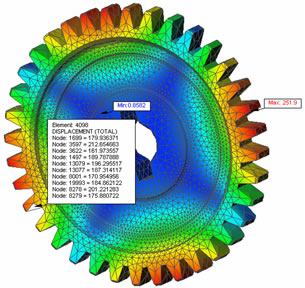 Nonlinear properties can now be stored in the NEi Fusion material database, allowing for the seamless reuse of these properties across models. Query displays are possible for real time information on model’s nodes and elements. |
With NEi Fusion on your desktop, NEi Software (Westminster, CA; formerly Noran Engineering) says you gain an analysis package that combines an FEA Modeler, pre- and postprocessing capabilities, and Nastran solvers — in other words, a fusion of Nastran FEA with the “best-in-class” 3D solid parametric modeler. Plus, with today’s announcement of V1.4, even newer enhancements abound.
Now small- and medium-size companies, consultants, and engineers who need affordable, professional-level simulation for product development, virtual testing, design validation, and quality assurance can see how designs will perform without waiting for prototypes, test fixtures, or actual field use.
NEi Fusion lets you apply forces, pressure, thermal conditions, temperature, vibration, and acceleration loads. You can see the deformation, stresses, strains, heat transfer, and modal shapes that your design will experience. Through contour plots, deformations, and vector displays, says NEi Software, you gain the engineering insights you need to innovate, optimize, and achieve the best quality, lowest manufacturing costs, and fastest time to market.
| “NEi Fusion’s combination of parametric CAD technology for model creation with high-accuracy Nastran solvers at an affordable price is game-changing technology for simulation at the design stage.” — Nicklaus Trebilcock, NEi Software, VP Software Development |
New Features in NEi Fusion V1.4
In the new 64-bit version of NEi Fusion V1.4, which is available both on Windows Vista and XP, beam element enhancements have simplified model creation, says the company, through multiple structural members that can be added simultaneously to a single physical property when creating beam elements.
Meshing enhancements include Normal Display, which lets you hide/display the shell element normals, with normals that can be viewed as vectors or front and back face colors.
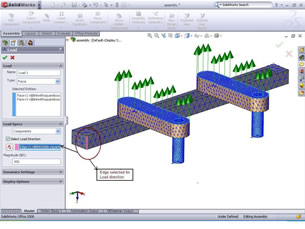 Here the direction of load is the tangent vector at the start of the selected edge/sketch curve. |
Reverse normals allows orientation of the shell element normals and reversal of element normals that lie on a face/surface. A Meshing Progress Bar displays the mesher’s progress, and Display Troubled Areas on Failed Meshes will let you know if the Part/Assembly has improper geometry generated during the creation of the part.
Postprocessing enhancements in V1.4 include the ability for table data input to be viewed as X,Y Plot; and dynamic results data during nonlinear analysis, in which plots can be created during a nonlinear analysis, will show maximum vector resultants vs. load factor. Nonlinear properties are now stored in the NEi Fusion material database, allowing the seamless reuse of these properties across models, says the company.
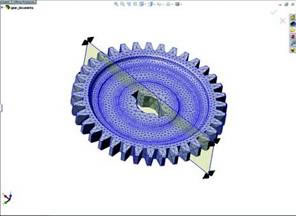 A Section Plane can be moved by clicking the Move Plane number box or it can be rotated about two axes using X Rotation and Y Rotation number boxes in the dialog. |
Load and boundary conditions enhancements allow for dynamic update of loads / constraints / rigid bodies as well as Load defined using edges. Another postprocessing enhancement is Section View. By checking the Section View check box in Contour Plot dialog, a section plane appears around the part/assembly. Three different section planes can be selected by clicking on the buttons — front plane, top plane, and right plane.
General enhancements in V1.4 include the ability to create Nastran bulk data file for incomplete models for snap-shot view and transferability as well as an FE model file can be saved with only geometric data for smaller file size. Others include a user-specified solver path, selective output of modal and transient analysis results for faster calculation time, smaller file size, and query displays real-time information on a model’s nodes and elements.
Plus, the highlight option allows a set of nodes or elements to highlight on the model, helping identify location and/or properties.
Contents Lead to Collaboration
In general, NEi Fusion’s offerings — which include beam elements, optimization and dynamic analysis, and upgrades to thermal analysis, combined with an automated impact analysis (AIA) wizard, meshing and postprocessing enhancements, onscreen display enhancements and customizations, and an Analysis Report Writer — meet engineering needs across the board.
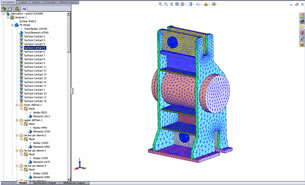 Total number of nodes/elements are displayed in an assembly tree view. |
The NEi Fusion Modeler is built on an industry-proven, Windows-based, fully associative, parameterized, feature-based, solid-modeling engine that provides advanced tools for fast, intuitive, and robust model creation. And CAD data import capabilities complement the 3D modeling tools to help engineers build models quickly when existing CAD files are available.
The NEi Fusion Pre-Processor is a utilitarian element library of solid, shell, and composite meshing capabilities, with a material library to ensure real-world fidelity and professional level simulation.
The NEi Fusion Nastran solvers enable the best possible real-world representation along with “extremely fast turnaround time on solutions,” says the company. In NEi Fusion, which comes with a choice of solver packages, various analysis types and capabilities will be limited depending on the level and configuration selected. The solvers can be purchased individually or bundled in one of two possible packages: Basic (which allows analysis and simulation of linear statics, modal analysis, buckling, prestress, and steady state heat transfer problems) or Expert (with all the analysis types in the Basic package and adds nonlinear analysis and transient heat transfer).
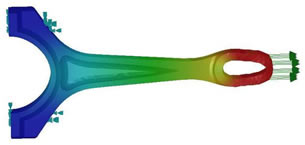 Loads and constraints can be shown on deformed plots. |
And the NEi Fusion Post-Processor, which provides images of deformations, contours, and vector displays to view your simulation results, is equipped with file sharing and import/export capabilities so that you can share FEA results with vendors, design partners, suppliers, customers, and other segments of your organization.
Two Configurations: Designer & Analyst
The affordable price of the Designer Configuration is achieved by coupling the NEi Fusion Modeler and the NEi Nastran solvers together but without functionality to work with other pre- and postprocessors. If wider level analysis capabilities are needed, an upgrade enables conversion to the Analyst Configuration for unrestricted use of NEi Nastran solver capabilities with other pre- and postprocessors.
In the Analyst Configuration, the NEi Nastran solvers are independent of the NEi Fusion Modeler and can work with any other pre- and postprocessors. This configuration is useful in environments where multiple pre- and postprocessors may be needed or are in use (e.g., NEi Nastran Modeler, FEMAP, Patran, HyperMesh, ANSA, etc.).
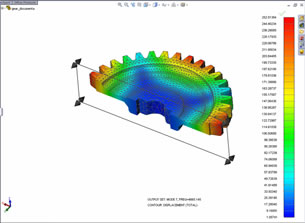 The Analyst Configuration includes the NEi Nastran Editor, which enables additional postprocessing capabilities, model data editing, and access to real-time solution data. Plus, only in the Analyst version, many features are included under the categories of Direct Matrix Input Grid (DMIG) Support, Global Matrix Output, Model Reduction, and Editor.
The Analyst Configuration includes the NEi Nastran Editor, which enables additional postprocessing capabilities, model data editing, and access to real-time solution data. Plus, only in the Analyst version, many features are included under the categories of Direct Matrix Input Grid (DMIG) Support, Global Matrix Output, Model Reduction, and Editor.
Nicklaus Trebilcock, vice president of software development at NEi Software, explains, “Companies must have the best product development process to survive on a globally competitive playing field. NEi Fusion’s combination of parametric CAD technology for model creation with high-accuracy Nastran solvers at an affordable price is game-changing technology for simulation at the design stage.”
CAD Geometry & Interoperability
The direct use of CAD geometry for analysis, combined with direct application of analysis input data to CAD geometry and 3D visualization of analysis results on original CAD geometry, are just a few of the general capabilities.
Native file translators to and from nearly all mechanical CAD products on the market are offered: SolidWorks, Pro/ENGINEER, Autodesk Inventor, Mechanical Desktop, Unigraphics, Solid Edge, CADKEY, IGES, STEP, Parasolid, SAT (ACIS), VDA-FS, VRML, STL, DWG, DXF, TIFF, JPG, Viewpoint, RealityWave, and HSF (Hoops). Plus, support of seamless integrated third-party bidirectional file translators (CATIA, Pro/ENGINEER) is complemented by supported standards of ANSI, DIN, ISO, GOSJIS, GB, and BSI.
Modeling Capabilities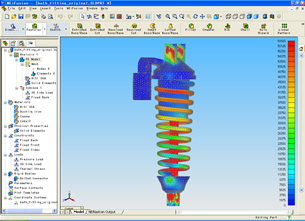 NEi Fusion V1.4’s feature-based, fully associative, parameterized solid modeling is enhanced by part modeling features like the FeatureManager dynamic design tree; in-place editing; integrated sketching; and the ability to extrude, revolve, and make feature patterns and holes. Advanced 3D operations include lofting, sweeping, complex blending, and filleting. Advanced shelling and midsurfaces, multi-body support, and advanced surface modeling that includes lofts and sweeps with guide curves, fill-in holes, drag-handles for tangency control, and so forth are also possible.
NEi Fusion V1.4’s feature-based, fully associative, parameterized solid modeling is enhanced by part modeling features like the FeatureManager dynamic design tree; in-place editing; integrated sketching; and the ability to extrude, revolve, and make feature patterns and holes. Advanced 3D operations include lofting, sweeping, complex blending, and filleting. Advanced shelling and midsurfaces, multi-body support, and advanced surface modeling that includes lofts and sweeps with guide curves, fill-in holes, drag-handles for tangency control, and so forth are also possible.
Meshing & Other Features
Attributes associated with meshing include global and local controls for part geometry with default sizing; mesh control on arbitrary user-defined regions; sketch line or curve meshing; free surface meshing: quads or triangles; continuous shell (quad or tri) meshing; auto mesh, loads, and constraints update with geometry changes; and a Mesher Status Window.
Analysis Types
Coordinate systems include user-defined Cartesian, cylindrical and spherical coordinate systems, and referencing global assembly for part or custom coordinate systems for loads and constraints. Analysis types include linear statics, normal modes, linear buckling, nonlinear stress, thermal stress, prestress static, composite, and more. And in composite analysis, various failure theories are supported including Hill, Hoffman, Tsai-Wu, Max. stress, Max. strain, and NASA LARC02.
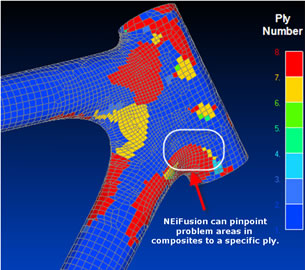 A composite analysis is shown of layers in a bicycle frame. |
NEi Fusion offers capabilities for the analysis of parts made from composite materials like carbon fiber and epoxy including materials’ support for the latest failure indices, First Ply Failure Analysis, postprocessing visualizations, and Progressive Ply Failure Analysis (PPFA). PPFA, a new simulation technology from NEi, lets you examine the propagation of damage through a structure after first-ply failure so that you can make an assessment of conditions for ultimate failure.
Optimization analysis is made possible by design objectives to minimize, maximize, or reach target values; optimize weight, stress, temperature, and natural frequency; and parametrically update geometry dimensions. Drop testing features offer an automatic impact analysis (AIA) wizard, acceleration and contact direction input, and time stepping automatically calculated based on natural frequency.
Postprocessing features include stress and deformation plots, principal and directional stress plot, strain plot, resonant frequencies, heat flux plots, isosurfaces, and more.
Plus, NEi Fusion’s Analysis Report Writer enables HTML-formatted reports for linear static analysis in a customizable report format with a step-by-step wizard for report-generation process that lets you include standard model data.
Demo Shows It All
In an online demonstration of NEi Fusion (see link for demo below), a finite element analysis (FEA) is performed on a simple part to illustrate the working environment of NEi Fusion. Plus, NEi Software is also offering webinars.
“NEi Fusion brings benefits to organizations that are new to FEA, as well as those established in simulation. Experienced organizations gain with NEi Fusion by introducing a tool for virtual test, design validation, “what-if” studies, and digital prototyping into their design section. With NEi Fusion, they break down barriers between designers by putting in place a common, sharable, trusted Nastran standard,” concludes Trebilcock.
See what NEi Software’s NEi Fusion V1.4 has in store.
Read why DE’s editors chose this as a Pick of the Week.
Take some time to view the 7-minute demonstration on NEi Fusion.
Sign up for NEi Fusion webinars.
Connect to NEi Software’s NEi Fusion webpage.
Download the pdf of the NEi Fusion Product Brochure.
Link to the Product Datasheets for NEi Fusion.
When you visit Nastran.TV, you can see two videos on NEi Fusion: 1) General Overview and 2) Composite Analysis.
View enhancements in previous release of NEi Fusion v 1.2.
Margaret S. Gurney is the editor for new products at Desktop Engineering magazine.
Subscribe to our FREE magazine, FREE email newsletters or both!
Latest News
About the Author
DE’s editors contribute news and new product announcements to Digital Engineering.
Press releases may be sent to them via [email protected].






